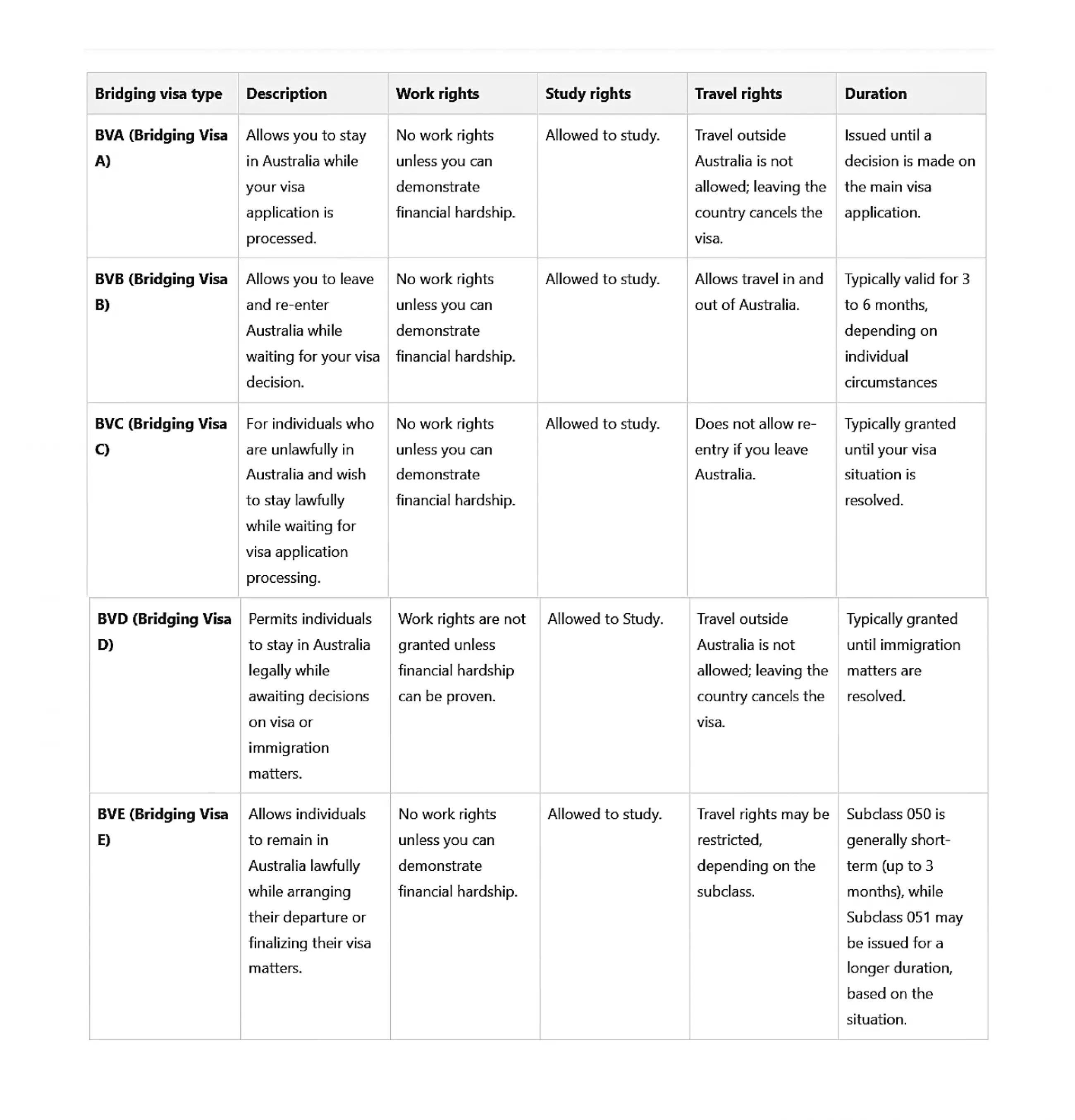Bridging Visas - Australia

A bridging visa is a short-term visa that enables people to remain in Australia while they wait for the results of their immigration or visa application procedure. People who need to leave and re-enter the country, are waiting for a decision on their protection or visa status, or are changing between visas frequently use it. Depending on the demands of the applicant, bridging visas can be granted under a number of subclasses and are essential for preserving legal status while a person's case is being handled. These visas guarantee that people won't be left in a state of legal uncertainty while their immigration issues are resolved.
-
What is a Bridging Visa?
-
What are the types of Bridging Visas?
-
Why would someone need a Bridging Visa?
-
Are Bridging Visas permanent or temporary?
-
Can I travel with Bridging Visa?
-
Bridging Visas and their specifications
-
What are the documents required for Bridging visas?
-
Can I work or study while on a Bridging Visa?
-
How long does a Bridging Visa last?
-
Comparison between all the Bridging Visas
What is a Bridging Visa?
A bridging visa is a short-term visa issued by the Australian government that permits an individual to remain in Australia legally while their immigration case is being handled. When requesting a new visa, contesting a visa denial or cancellation, or breaking the law, it is utilised. A bridging visa is non-substantive and does not grant additional migration rights, in contrast to regular visas. It prevents unlawfulness while the Department of Home Affairs reaches a judgement by filling in the gaps between visa stages.
What are the types of Bridging Visas?
-
Bridging Visa A (BVA)
The Bridging Visa A lets individuals stay in Australia while their new visa application is processed. Holders are not allowed to leave Australia and if they do, the visa is cancelled, and they must apply for a new visa to re-enter. For travel, they must apply for a Bridging Visa B (BVB). -
Bridging Visa B (BVB)
This visa is for those with a Bridging Visa A who need to leave Australia temporarily during the visa application process. Holders can apply for this visa and, if approved, can leave and re-enter Australia. It is a temporary visa, allowing travel for personal or business reasons, but must be approved before leaving. It does not automatically grant work rights, but they can be requested if financial hardship is demonstrated. The visa is valid for a limited time and requires re-entry before it expires. -
Bridging Visa C (BVC)
The Bridging Visa C is for people unlawfully in Australia who are seeking to resolve their immigration issues or apply for a new visa. This visa does not allow travel. If the holder leaves Australia, their visa will be cancelled, and they must apply for a new visa to re-enter. This visa provides time to appeal a visa refusal or cancellation. Travel and work rights are not granted unless specifically approved. -
Bridging Visa D (BVD)
The Bridging Visa D is for individuals without legal status in Australia who are unable to submit a valid visa application. It allows individuals to stay lawfully in Australia while resolving their immigration status. This visa does not grant travel rights; therefore, leaving Australia will cancel the visa. Work rights are not automatic, but they may be requested if financial hardship is proven. It is a temporary visa, typically granted for a short time while individuals plan their departure or resolve their status. -
Bridging Visa E (BVE)
The Bridging Visa E is for individuals unlawfully in Australia, such as those who have overstayed their visa or entered without one. It allows them to remain while applying for a new visa or planning their exit. Like the BVC and BVD, the BVE does not allow travel. If the holder leaves, the visa will be cancelled. This visa often comes with restrictions on employment, study, and housing and provides individuals time to regularize their immigration status after overstaying their visa.
Why would someone need a Bridging Visa?
A Bridging Visa allows individuals to stay lawfully in Australia while waiting for the decision on their new visa application. It is also used when appealing a visa refusal or cancellation or when an individual has overstayed their visa or failed to apply for a visa in time. Certain Bridging Visas allow for a temporary lawful stay while individuals arrange their departure from Australia. For example, a Bridging Visa may be used when moving from a student visa to a graduate visa.
Are Bridging Visas permanent or temporary?
Bridging Visas are always temporary. They are not designed to lead to permanent residency and do not provide permanent immigration rights. The primary purpose of a Bridging Visa is to ensure you are legally recognized in Australia while:
-
Waiting for a decision on a new visa,
-
Contesting a visa denial or cancellation,
-
Planning to leave the country,
-
Transitioning between different types of visas.
A Bridging Visa expires when:
-
Your new visa is granted,
-
Your appeal or application is denied, and all appeal rights are exhausted,
-
You depart from Australia.
Although some Bridging Visas may have limitations, they are not intended for long-term residence, work, or study.
Can I travel with a Bridging Visa?
Travel rights depend on the specific Bridging Visa you hold. If you have a Bridging Visa A, you are not allowed to travel. If you leave Australia, your visa will be revoked, and you will need to apply for a new visa to return. For travel, you must apply for a Bridging Visa B, which allows you to leave and return to Australia if approved before departure. Always check the exact terms listed on your Bridging Visa grant notification before making any travel plans.
Bridging Visas and their specifications
-
Bridging Visa A (BVA) – Subclass 010
Designed for individuals who wish to remain in Australia legally while waiting for a decision on their visa application. No travel rights are granted; leaving Australia cancels the visa. -
Bridging Visa B (BVB) – Subclass 020
For those with a BVA who need to travel while their visa application is in process. Grants the right to travel if approval is obtained before leaving. Valid for a limited period (usually 3–12 months). -
Bridging Visa C (BVC) – Subclass 041
For individuals unlawfully in Australia who wish to apply for a new visa. No travel rights are granted; leaving Australia cancels the visa. -
Bridging Visa D (BVD) – Subclass 041
For individuals who cannot submit a valid visa application. No travel rights; leaving Australia cancels the visa. Typically granted for a short time while preparing to leave or resolve immigration status. -
Bridging Visa E (BVE) – Subclasses 050/051
For individuals needing time to apply for a new visa or prepare to leave Australia. No travel rights are granted; leaving cancels the visa. Often issued with conditions limiting employment, study, and housing.
Can I work or study while on a Bridging Visa?
Depending on your visa type and its terms, you may be able to work or study while on a bridging visa.
-
Bridging Visa A
No automatic work rights, in general. If you can demonstrate financial hardship, you can seek for employment rights. You can study. -
Bridging Visa B
If your prior visa permitted it, you can work and study. Depending on your circumstances, you may potentially be awarded work rights. -
Bridging Visa C
No rights to work automatically. You must demonstrate your financial need in order to apply for employment rights. You can study. -
Bridging Visa D
No work rights until a hardship-based approval is obtained. There may be limitations on the study. -
Bridging Visa E
Work rights are not granted unless you apply and demonstrate hardship. Studying is permitted, but be aware of any limitations.
How long does a Bridging Visa last?
Temporary visas known as "bridging visas" are valid until your immigration case is settled, such as the result of your appeals or visa application. The type of visa and the specifics of your application will determine how long a bridging visa lasts.
-
Bridging Visa A, remain in effect until the visa is revoked or a decision is made about your subsequent application. Depending on your travel requirements and the length of time it takes to process your visa.
-
Bridging Visa B, are typically good for three to twelve months.
-
Bridging Visa C, are typically good until your unlawful status is resolved or until your new visa application is decided.
-
Bridging Visa D, are typically granted for brief periods of time while you prepare to go.
-
Bridging Visa E, continues for however long it takes you to complete your application or make plans to depart.
Latest Insights

Bridging Visas - Australia

How to create an ImmiAccount?

